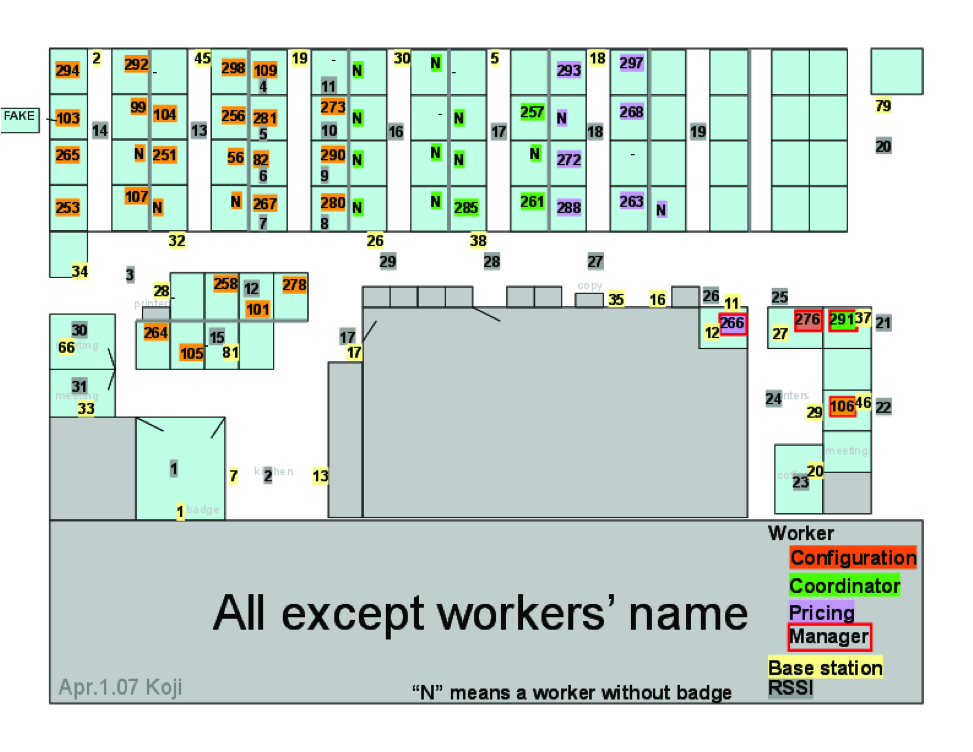Reality Commons
brought to you by the MIT Human Dynamics Lab
Badge Dataset
The data contain the performance, behavior, and interpersonal interactions of participating employees at a Chicago-area data server configuration firm for one month. It is the first data set to contain the performance and dynamics of a real-world organization with a temporal resolution of a few seconds. This data was collected by Daniel Olguin, Ben Waber, Tamie Kim, and Alex Pentland in 2007 using Sociometric Badges (see http://sociometricsolutions.com for details about the badges). The citation for this data set is:
Performance data include the assigning time, closing time, difficulty level, assigned-to, closed-by, and number of follow-ups of each task completed during that one-month period. Behavior data include the locations of the employees estimated from Zigbee RSSI recorded by the badges worn by each employee, representing to whom and to which key locations (printer, warehouse, and so on) he went. Behavior data also include the recordings of a 3-axis accelerometer on the badge, from which we estimate the postures and activities of its wearer. Interaction data include IR scanning by each badge of the badges worn by other employees, indicating that the latter are within a 1-meter distance and 30-degree cone in front of the badge, most likely indicating face-to-face communication. The badges also record audio intensity from an on-badge microphone, from which we estimate verbal behavior and verbal interactions. All sensor data are time-stamped.
There were 28 employees at the firm, of which 23 participated in the study. Nineteen-hundred hours of data were collected, with a median of 80 hours per employee. The resulting data document the performance of computer system configuration tasks assigned to employees on a first-come, first-served basis. These configurations were rated to one of three levels of difficulty (basic, complex, or advanced) based on the configuration characteristics. At the conclusion of the task, the employee submitted the completed configuration as well as the price back to the salesman, after which the employee moved to the back of the queue for task assignment.
The layout of the workspace is shown in the Floor Plan. The base stations on yellow squares were placed at fixed positions throughout the workspace in order to locate the badges and time-stamp the data collected by them. Participating employees are indicated at their cubicles by their badge IDs; different colors behind the IDs represent different departmental branches at the firm. Non-participating employees have letter "N" at their cubicles. Employees fetched their badges from the room containing base station 1 (located at the lower left corner) at approximately 9am each weekday morning, and returned the badges to this room at around 6pm in the evening. The RSSI regions were manually assigned to identify different regions in the workspace, and do not correspond to any particular sensors deployed in this experiment.
The employees indicated that their configuration tasks were information-intensive, and therefore required them to talk to one another to fully understand the various specifications. As such, we would expect a positive correlation between the rate of problem-solving by an employee and the number of places visited by that employee. Further, from who visited whose work cubicle we can determine interpersonal information flow and expertise in problem-solving.

Figure Floor Plan: The configuration, coordination, and pricing branches in the organization each have their own spaces. Each participating employees was assigned a badge with a unique ID, and base stations with unique IDs were placed at fixed locations for time-sampling data records and for localization.


